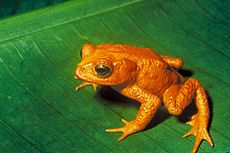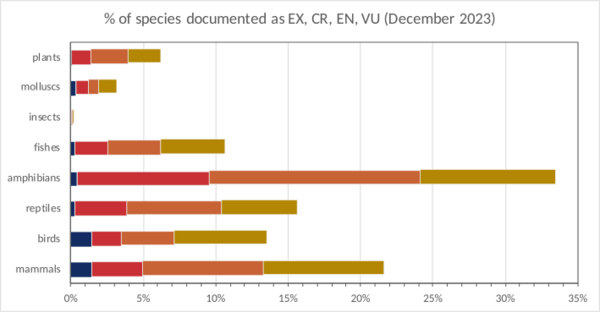IUCN Red List facts for kids
 |
|
| Formation | 1964 |
|---|---|
| Headquarters | Cambridge, England |
|
Region served
|
International |
|
Official language
|
English |
|
Parent organization
|
International Union for Conservation of Nature |
| Affiliations | Species Survival Commission, BirdLife International, Conservation International, NatureServe, Botanic Gardens Conservation International, Royal Botanic Gardens, Kew, Texas A&M University, Sapienza University of Rome, Zoological Society of London, Wildscreen |
The IUCN Red List of Threatened Species, often called the IUCN Red List or Red Data Book, started in 1964. It's like a global report card for plants and animals. It tells us which species are in danger of disappearing forever. Countries and groups also make their own lists for specific areas.
The main goal of the Red List is to share scientific facts about species around the world. It helps everyone understand how many plants and animals are in trouble. This information helps leaders make choices to protect nature. It also guides people working to save our planet's amazing variety of life.
Many expert groups help create the Red List. These include BirdLife International and teams from the Zoological Society of London. The IUCN Species Survival Commission also has many specialist groups. Together, these experts assess almost half of all species on the list.
The International Union for Conservation of Nature (IUCN) tries to check each species' status every ten years. For some, they check every five years. Experts review these assessments carefully. Different groups are responsible for different species or areas. For example, BirdLife International handles all birds. The IUCN team also finds new partners to help with this important work.
More and more species are being added to the Red List over time. As of 2023, experts had looked at over 150,000 species. Sadly, more than 42,000 of these are at risk of disappearing. This is mainly due to human actions like too much fishing, hunting, and building on natural lands.
Contents
A Look at the Red List's History
The idea for a 'Red Data Book' first came from Peter Scott in 1963.
Early Days of the Red List
At first, the Red Lists were for scientists. They were printed in a special way so pages could be updated easily. The first lists, published in 1966, focused on mammals and birds. Later, lists for reptiles, amphibians, plants, and freshwater fish were added. These early lists helped experts keep track of species.
In 1969, a book called The Red Book: Wildlife in Danger was made for everyone, not just scientists. It talked about many animals, especially mammals and birds. It also included sections on reptiles, amphibians, fish, and plants.
Growing the List: More Species Assessed
Over the years, the Red List has grown to include many more species. In 2007, for example, experts changed the status of some gorillas. They moved them from 'endangered' to 'critically endangered'. This was because of threats like diseases and poaching. This meant these gorillas were very close to disappearing from the wild.
By 2012, the list included over 63,000 species. It showed that many amphibians, corals, conifers, mammals, and birds were facing extinction. Each update helps us see the big picture of how wildlife is doing.
How Species are Classified: Red List Categories
| Conservation status | |
|---|---|
 |
|
| Extinct | |
|
|
| Threatened | |
|
|
| Lower Risk | |
|
|
|
Other categories |
|
|
|
|
Related topics
|
|
 Comparison of Red list classes above and NatureServe status below  |
|
The IUCN Red List puts species into nine main groups. These groups are based on things like how fast their numbers are dropping. They also look at how many are left and where they live. Even if there isn't perfect data, experts can still make a judgment. They consider possible future dangers if there's good reason to believe them.
Understanding the Categories
Extinct (EX)
This means there is no reasonable doubt that the species is completely gone. No living individuals are left anywhere in the world.
Extinct in the Wild (EW)
These species only survive in zoos, botanical gardens, or special breeding programs. They no longer live freely in their natural homes.
Critically Endangered (CR)
Species in this group are in an extremely serious situation. They face a very high risk of disappearing from the wild very soon.
Endangered (EN)
These species face a very high risk of extinction in the wild. They meet specific criteria that show they are in great danger.
Vulnerable (VU)
Species listed as vulnerable are at a high risk of becoming extinct without more help. They need human action to survive.
Near Threatened (NT)
These species are close to being classified as endangered in the near future. They are not yet in immediate danger but could be soon.
Least Concern (LC)
These species are widespread and have large, healthy populations in the wild. They are not currently at risk.
Data Deficient (DD)
For these species, there isn't enough information to assess their risk of extinction. More research is needed.
Not Evaluated (NE)
This means the species has not yet been assessed by the IUCN Red List.
What "Threatened" Means
When the IUCN Red List says a species is "threatened," it includes three categories. These are Critically Endangered, Endangered, and Vulnerable. These are the species that need our help the most.
"Possibly Extinct" Tag
Sometimes, experts use a special tag called "possibly extinct" (PE). This is for species that are Critically Endangered but might already be gone. There's also a "Possibly Extinct in the Wild" tag. This is for species that might only exist in captivity, not in nature.
Images for kids
See also
 In Spanish: Lista Roja de la UICN para niños
In Spanish: Lista Roja de la UICN para niños
- CITES
- Conservation status
- Red List Index
- Regional Red List
- Species by IUCN Red List category
- Wildlife conservation


